Donald Trump's Telling Change to the Oval Office
Here’s a little quiz. Take a look at the picture of the photo above, which shows the newly redecorated Oval Office that is occupied by Donald Trump. What’s unusual in this scene?
As a helpful hint, here’s a close-up of the area you should be looking at:
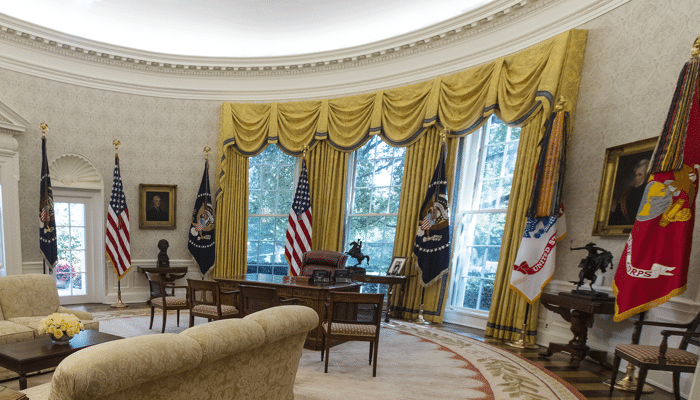
Is it the Remington bronze statue known as “The Bronco Buster” on the right, which many presidents have displayed? No. The portrait of Andrew Jackson just above the statue, which has survived the departure of Jackson-fan Steve Bannon? No. The bust of Lincoln, on the left? Beneath the portrait of Jefferson? No, and no—although it would be instructive to know the thoughts of the third and the 16th presidents as they gaze on the 45th.
Recommended: Why Do Some People Decide to Ride Out Hurricanes?
Might it be additional gold in the decor? No, not even that.
Here are a few additional compare-and-contrast clues, based on photos of the same office in different eras.
Let’s start with an extreme case, the Oval Office of FDR:
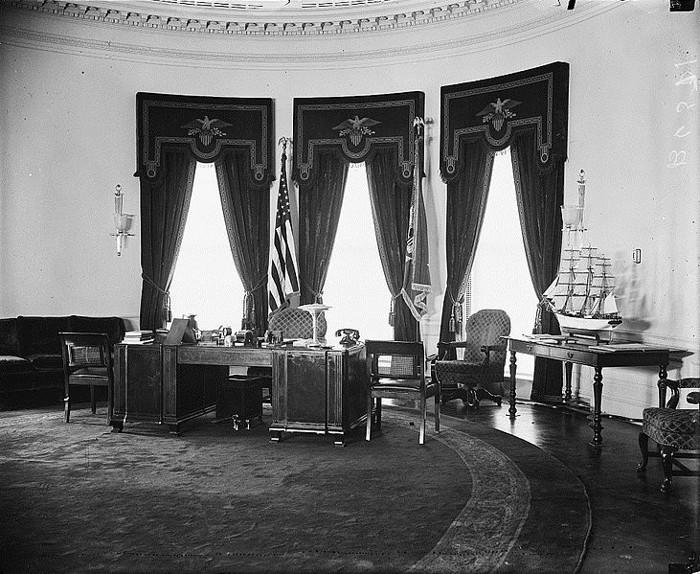
Maybe too many points of contrast here—black and white versus color, the ship on the desk (for a former Assistant Secretary of the Navy), the very different aesthetics of patrician spareness and Trumpian glitz.
Recommended: What a Better Democratic Populism Might Look Like
Let’s skip ahead to Dwight Eisenhower, whose office looked this way (via a recreation at his museum):
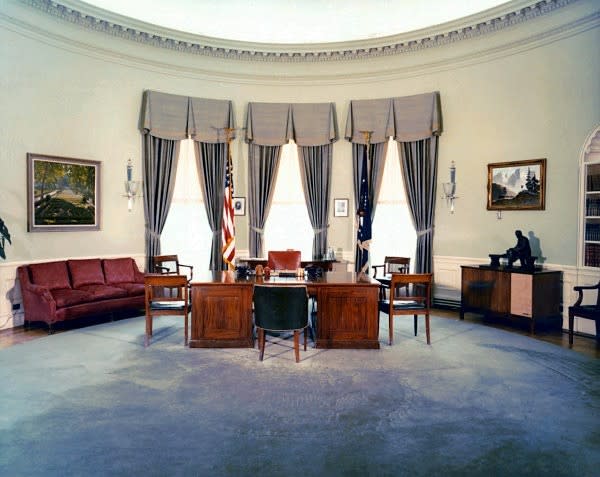
And how about JFK:
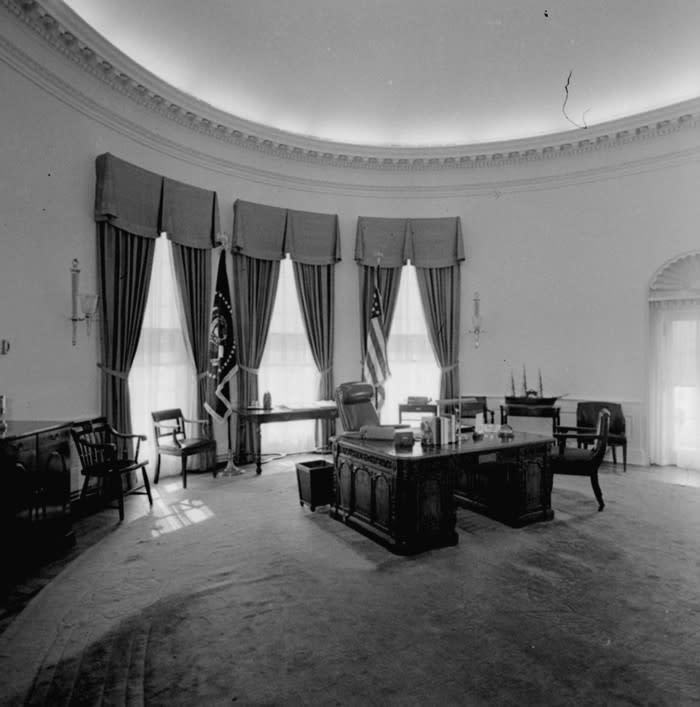
And Lyndon Johnson with his advisers, getting news in 1968 about the assassination of Martin Luther King:
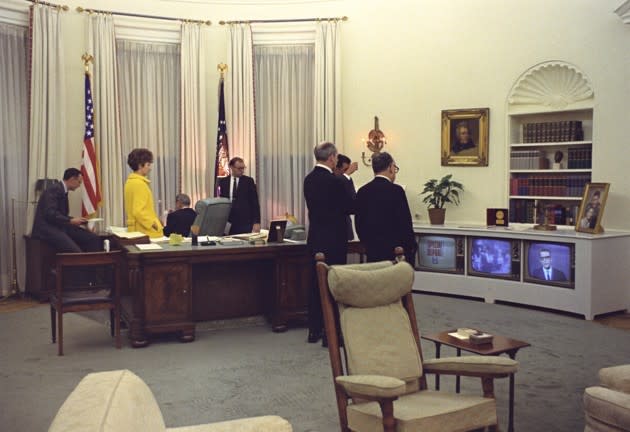
I won’t go through the whole list but will move to a a sharper compare-and-contrast series from some recent presidents. On the left in each view, previous Oval Offices. On the right, the new one for Trump.
Recommended: 'The Republican Party Is Unified in Revulsion'
Reagan and Trump:

Bill Clinton and Trump:

George W. Bush and Trump:

And finally, Obama and Trump:

Can you spot the difference? Of course there are lots of them. But I’m thinking of the flags.
* * *
Most previous presidents contented themselves with two large flags behind their desk. One, naturally, is the stars-and-stripes American flag. The other is the blue flag bearing the presidential seal. Trump has at least tripled that: In the photos of the new Oval Office, we see three U.S. flags and three presidential ones.
But that’s not all. As commander-in-chief of all United States armed forces, the president is frequently in places where the battle flags of the five branches of service are displayed. (For the record: Army, Navy, Marine Corps, Coast Guard, and Air Force.) Those flags are adorned with “battle streamers” for the campaigns in which the services have seen action. There are a lot of these streamers. The Army’s flag has nearly 200, which hang so densely that it’s hard to see the flag itself.
Presidents are used to the battle flags. The flags are in some meeting rooms where the president spends time, and sometimes behind him on stage. Dwight Eisenhower—West Point graduate, former five-star Army general—had the Army flag sentimentally at one end of the Oval Office.
But with rare exceptions, presidents keep the battle flags out of the Oval Office. Their decisions even follow a Chickenhawk-style pattern: The more closely a president has been involved with the military, the less likely he is to make a military-flag display.
FDR and Eisenhower, who in different ways commanded the forces that beat Hitler and Tojo, did not need the battle flags. Nor did JFK, wounded Navy veteran of that war—nor the first George Bush, shot down as a naval aviator over the Pacific, nor Gerald Ford, who also served in the Pacific with the Navy, nor Jimmy Carter, who was an Annapolis midshipman in the early 1940s and then became a submarine officer. Nor Ronald Reagan, who for all the complexities of his “war record” (mainly in movies) radiated a confident toughness. Of the Boomer-era presidents (Clinton, George W. Bush, technically Obama), only Bush was in the military, via the National Guard, but until now all did without the battle flags.
The exceptions? Some photos of Richard Nixon in the Oval Office show him with battle flags, and a few of Lyndon Johnson as well. These exceptions underscore, rather than undermine, the larger chickenhawk principle: that the stronger a leader actually is, the less he needs the stage-prop symbols of strength. (Both Johnson and Nixon were in uniform during World War II but in circumstances less dramatic than Kennedy’s or Bush’s. In different ways each was preoccupied with, and ultimately badly damaged by, avoiding the appearance of weakness or compromise. They were also the two modern presidents to leave office early without being voted out--or dying: Johnson by declining to run in 1968, Nixon by resigning just ahead of impeachment in 1974.)
And now we have Trump. The mainly white flag nearest his desk is the Army’s; the red one is the Marine Corps’s. (I can’t tell from this photo whether the other three service banners are there as well.) Make what you will of this change, but what I make of it is this: The man with the least demonstrated policy-knowledge of any modern president frequently boasts about how smart and well-educated he is. Similarly, the man exempted from the draft because of a bone spur—either in his right foot, or his left, he’s not sure now—surrounds himself with triple the symbols of national power as his predecessors needed, and with emblems of the military that the previous strongest commanders-in-chief kept out of the seat of ultimate civilian control.
Does any of this “matter”? No. But it’s one more step away from normal and thus worth noting. Whoever comes next to the Oval Office should feel confident enough to put those battle flags back where they belong.
Read more from The Atlantic:
This article was originally published on The Atlantic.

